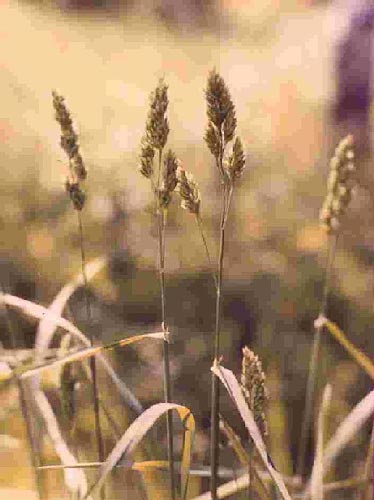Relatives
Dactylis glomerata L. - Cocksfoot.
Systematic position.
Family Poaceae Barnhart, Genera Dactylis L.Morphology and biology.
Perennial, short rhizomatous grass. Height is 60-150 cm. It has numerous vegetative stems and several generative ones (straight, bare). Leaf sheath is closed along its entire length, depressed, bare or pubescent. Leaf lingula is 6 mm in length, chaffy. Leaf is 4-10 cm in width, green, plane, soft, rough. Inflorescence is panicle up to 15 cm in length, depressed on both sides, compact or sprawling, with elongated, down-turned branches. Spikelet is 6-8 mm in length, with 3-5 flowers, elongated, elliptical, compressed on each side, sometimes violet color. Lower glumes are pubescent along carina. Lower floral glumes are equal in size. Axis is short (up to 1 mm long), straight, pubescent along carina and edges. Cross-pollinated and wind-pollinated. Flowering occurs in June-July. Seed and vegetative reproduction. Chromosomal number 2n=28.Distribution.
Occurs throughout the European part of the former USSR (except the Arctic), Caucasia (except the extreme south), Western Siberia (except the Arctic), Eastern Siberia (southern part of Yenisei and the Angara basin), the Far East (invasive in Kamchatka, Sakhalin, Kurils, and the Ussuri district), Central Asia (the northeastern part), Scandinavia, Atlantic and Central Europe, the Mediterranean, Asia Minor, northwestern Iran and Mongolia; adventitious or introduced in several other countries.Ecology.
Species occurs in meadows, mainly in flood plains and damp, waterlogged meadows; grows along pond banks, often in clay, sand, alkaline soils, in well-lit forests, near shrubs, in inhabited localities, and sometimes by roads; grows as high as the upper mountain zone. It grows best in neutral and slightly acidic soils, worse in dry soils. It occurs in peaty and peaty-clay soils. It does not grow in saline sand. It is one of a group of water-resistant plants. It is resistant to long floods (up to 45 days) but not resistant to stagnant floods. Species can dominate in phytocenosis. Hydromesophyte. It is frost-resistant.Economic value.
Forage, for haying and pastoral use. It is digested well by cattle. It can be used for grass plots.Related references:
Cherepanov, S.K. 1988. Plantae Vasculares Rossicae et Civitatum Collimitanearum (in limics USSR olim). St. Petersburg: Mir I Semia, 990 pp. (in Russian)Kovalevskaja S.S., ed. 1968. Conspect of Middle Asia Flora. Vol. 1. Taschkent: Publishing House Acad. Sci. Uzbekistan SSR, 226 pp. (in Russian)
Shishkin B.K., ed. 1950. Flora of Kirghizia. Vol. 2. Frunze: Publishing House Acad. Sci. Kirghizia SSR, 315 pp. (in Russian)
Tzvelev, N.N. 1976. Poaceae USSR. L.: Nauka, 788 pp. (in Russian).


